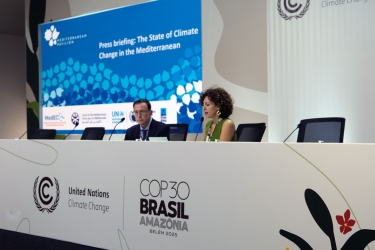Forest disturbance management in a new decade

The European Forest Institute kindly invites you to the conference “Collaboration – key to forest disturbance management in a new decade”, taking place on 26-27 August 2020. Join the virtual conference to hear about best practice examples and lessons learned in disturbance management from Forest Risk Facility network members!
Challenging present and future for our forests
Storms, bark beetle outbreaks, fires, droughts and other forest disturbances are challenging European forests. In the last decades, forest disturbance regimes have intensified and increased in frequency, size, duration, and intensity. Storms are unpredictable and can severely affect the forestry sector, as demonstrated by the Vaia Storm in Italy (October 2018), or the ice storm in Slovenia (February 2014). Bark beetle outbreaks are causing devastating effects on the ecosystem and timber provision across Central Europe. Fire seasons are increasing in lengths and intensity (not only in the Mediterranean anymore), as we saw in Portugal during the summer of 2017. Additionally, wildfires are getting more attention also in non-fire prone countries, such as Germany or the UK , where a “fire risk culture” is not yet established.
Considering the increasing forests risk, forest resilience gained more importance, pushing forest experts to find new strategies to manage ecosystems under uncertain present and future scenario.
Collaboration, support, capacity building and knowledge transfer
The actual hazard crisis and disaster management experience is based on suppression, monitoring and emergency management. However, suppression and recovery are not enough: there is a need to develop a more holistic approach to forest risk management integrating prevention and preparedness measures. Trans-national collaboration and support, capacity building and knowledge transfer increase can successfully address disaster risk management. This involves translating forest disturbance research in action. Science-based best practice guidance can inform policy makers and forestry practice, empowering personal and institutional expert capacity.

SUstaining and Enhancing REsilience of European Forests (SURE), the European Forest Risk Facility
Connecting science, practice and policy, the constitution of the Risk Facility is one of the main objectives of the project SUstaining and Enhancing the REsilience of European Forests (SURE) coordinated by EFI’s Bonn Office. Together with risk management stakeholders from all across Europe, the European Forest Risk Facility, an innovative platform of exchange and knowledge transfer on forest disturbances, risk prevention and management, was established. In the past three years, the SURE project involved organisations and experts from all over Europe in networking activities, events, workshops and exchange of experts, to enhance and strengthen public relations and transnational collaboration.
Register for the conference “Collaboration – key to forest disturbance management in a new decade”
To conclude three years of SURE project and look beyond, the virtual conference “Collaboration – key to forest disturbance management in a new decade” takes place end of august. The conference offers an open discourse on the future of the European Forest Risk Facility, and you will hear from forest resilience practitioners, researchers, and policy makers sharing best-practice examples in disturbance management.
The first day (26th August) is open for members and those interested in the SURE programme. Through presentations and interactive activities, we will explore the forest related risks and ways to actively engage stakeholders at all levels in exchange of good practices.
The second day (27th August) is open to policy makers to discuss the future of the RISK Facility. Therefore the results and inputs from the first day will be addressed to the policy makers and serve as the basis for the panel discussion. The focus will lay on the following questions:
- Where are shortcomings in effective disturbance risk management in different European regions?
- How can we move from often short-term decisions to long-term oriented disturbance mitigation and resource use in policy-making and practice to create a more resilient forest sector?
- How can the various actors involved in implementing measures for prevention and preparedness be better supported in view of future disturbance events?
Detailed information about the programme and speakers you can find here.
To join the conference on the 26th of August , please register via this link: https://www.eventbrite.co.uk/e/collaboration-key-to-forest-disturbance-management-in-a-new-decade-tickets-110960227026.


